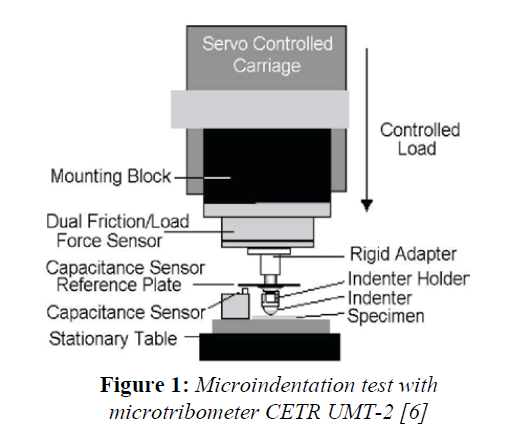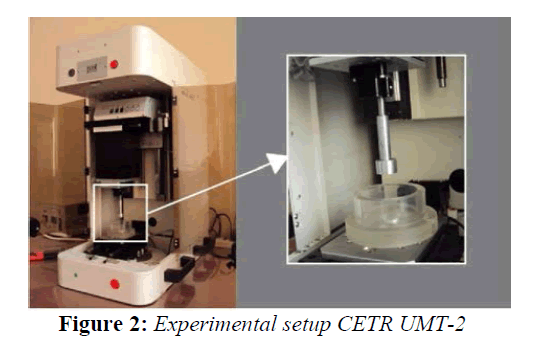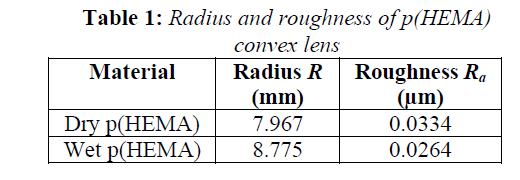ISSN: 0970-938X (Print) | 0976-1683 (Electronic)
Biomedical Research
An International Journal of Medical Sciences
Review Article - Biomedical Research (2015) Applications of Rapid Prototyping Techniques in Bio-Materials ARTBM2015
Structural And Mechanical Behaviour Of P(Hema) Hydrogel For Lumbar Disc Prosthesis.
Poly(2-hydroxyethyl methacrylate) - p(HEMA) - is a biocompatible polymer that forms a hydrogel when mixed with water. Water content and oxygen permeability, mechanical properties of p(HEMA) hydrogel can be controlled by cross-linking rate or by copolymerization; that is why p(HEMA) hydrogels have multiple biomedical applications. This paper objective was to analyse a biomaterial made of p(HEMA) for its use as intermediate element within intervertebral disc prosthesis on lumbar spine. Transparent lenses form p(HEMA) biomaterial is used in this study. The mechanical and structural characterization of polymer based on p(HEMA) has included surface topographic analysis, determination of swelling rate and X-ray diffraction , compactness, optical and electron microscopy analysis, indentation tests and preliminary compression tests. Intervertibral discs are manufactured by many conventional technique but due to increased advancement in implantation, Rapid Prototyping takes wide platform with greater mechanical property.
Keywords
biomaterial, hydrogel, mechanical properties, p(HEMA),Rapid Prototyping, Intervertibral disc.
Introduction
Polymers and copolymers based on 2 hydroxyethyl methacrylate (HEMA) are hydrophilic materials; after absorption of water to a state of equilibrium, they behave as elastic gel and in this form they are known as hydrogels [1]. Polymers are high molecular weight chemical substances produced by polymerization reaction from a large number of low molecular weight identical molecules called monomers. Copolymers are macromolecular compounds obtained by the mixed polymerization of two or more different monomers (copolymerization). The first and the most successful application of hydrogels based on HEMA was in the ophthalmology for hydrophilic contact lenses with excellent clinical results. Subsequently, it was successfully used to manufacture artificial lens and artificial cornea. Today HEMA hydrogels have many biomedical applications, such as bone replacement material or artificial cartilage [1,3].
In dry state, poly(2-hydroxyethyl methacrylate) - p(HEMA) – is a hard and brittle material. After swelling, it becomes soft and flexible and can be easily cut with a scalpel or scissors. Transparent hydrogels of p(HEMA) allow diffusion of liquids, suggesting the existence of a porous structure. Mechanical properties, water content and oxygen permeability of p(HEMA) hydrogel can be controlled by cross-linking rate or by copolymerization; that is why p(HEMA) biocompatible hydrogels have multiple biomedical applications [1,4].
The purpose of this paper was to characterize a biomaterial made of p(HEMA) for its use as intermediate element within intervertebral disc prosthesis on lumbar spine. The p(HEMA) biomaterial used in this study was in the form of transparent lenses. The mechanical and structural characterization of polymer based on p(HEMA) from this study has included surface topographic analysis, determination of swelling rate and compactness, X-ray diffraction, optical and electron microscopy analysis, indentation tests and preliminary compression tests.
2. Materials and Methods
The biomaterial based on p(HEMA) hydrogel which was used in this study was in the form of preforms of transparent artificial lens. This polymer was chosen because, in addition to being biocompatible, fully hydrated is a hydrogel used as artificial cartilage with properties similar to natural articular cartilage. Maximum degree of swelling of these lenses is reached after a time of 48h in distilled water or physiological serum [2].
Laboratory of Tribology India ltd , Padi, Chennai. With indentation tests, the modulus of elasticity and microhardness have been obtained for dry and hydrated p(HEMA) convex lenses.
Microindentation tests have been performed using the sensor of 0.2 - 20 N with a resolution of 1 mN and a diamond conical indenter at 120° and spherical tip radius of 200 μm. A capacitive sensor was used to measure the depth of indenter penetration. The scheme of indentation test using the tribometer is shown in Fig. 1.
Preliminary compression tests have been realised in order to study the rigidity and the damping capacity of dry and wet p(HEMA) hydrogel. The tests have been performed using the same microtribometer which was adapted with a circular plane indenter of 20 mm diameter (Fig. 2). Preliminary compression tests have been performed at a constant speed of 0.1 mm/s and with a maximum displacement of 0.5 mm in dry and wet p(HEMA) samples.
3 Results and discussions
3.1 Surface topographic analysis
Several roughness measurements have been executed; the mean values of this parameter are listed in Table 1 and it shows an example of topographic analysis for dry and hydrated convex lenses obtained with Taylor Hobson roughness tester. From Tables 1 it can be observed that not only the size and mass of the hydrogel changes due to fluid absorption, as expected, but the surface roughness of spherical cap.
3.2 Swelling rate and compactness
Maximum degree of p(HEMA) swelling was of 30.5% and the liquid content from hydrated lens was 0.079 g. The pore volume from wet lens was of 0.079 cm3. Fig. 1 have presented only the dimensions which have been measured accurately (with micrometer), the others being approximated from the profile analysis using roughness tester. The total volume of hydrated lens geometrically determined was 0.272 cm3. Also, the values of effective porosity and compactness of p(HEMA) hydrated lens were 29% and respectively 71%.
3.3 XRD analysis
XRD analysis has showed that both dry and wet p(HEMA) lens has a amorphous structure, resulting a diffractogram with three peaks unclear contoured to 18.5°, 32° and 42° 2Theta .
3.4 OM and SEM
Because of the lens transparency, OM images have shown a closed porous structure and a number of concentric circles on the inferior lens surface; these concentric circles have resulted from lens processing .Also, as OM images, SEM images indicated closed pores, concentric circles and the centre point which have resulted from processing of the inferior surface .
The damping capacity of dry and wet p(HEMA) convex lenses can be evaluated from load-time curves .Thereby, at the same compressive load, for example 2 N, the time is 1.1 s for dry lens and 3.9 s for wet lens. The sample which records the greatest time at the same load is considered to have a better damping capacity than the others. Therefore, the wet p(HEMA) have a much better damping capacity than in dry state and could assure an adequate mechanical shock absorption as intermediate element within intervertebral disc prosthesis on lumbar spine.
It is well known that the mechanical and structural characteristics of hydrogels based on p(HEMA) can be controlled to become very close to the natural joint cartilage [1-4] (particularly to the natural intervertebral disc) which presents a good damping capacity; for example, the values of the elasticity modulus, oxygen permeability and water content can be controlled to be similar [1,3]. In the author’s opinion these p(HEMA) hydrogels that are used for contact lenses and artificial cartilage could also be used in total lumbar disc arthroplasty as a intermediate element to assure a mechanical shock absorption.
4 Conclusions
The purpose of this paper was to analyse a p(HEMA) hydrogel for its use as intermediate element within total disc prosthesis on lumbar spine. The p(HEMA) biomaterial used in this study was in form of transparent lenses. The mechanical and structural characterization of dry and wet polymer based on p(HEMA) has included surface topographic analysis, determination of swelling rate and compactness, X-ray diffraction, optical and electron microscopy analysis, indentation tests and preliminary compression tests. The mechanical and structural characteristics have indicated that p(HEMA) hydrogels could also be used in lumbar disc arthroplasty as a mechanical shock absorption material.
References
- Bostan L. E., “Materiale polimerice cu hidrofilie controlat cu aplica ii în ingineria tisular a acartilajului articular”, PhD thesis, Faculty of Chemical Engineering and Environmental Protection, Iasi, Romania, 2011.
- Corneci M. C., “Fonctionnement tribologique des articulations synoviales pathologiques: Role des interfaces phospholipidiques” PhD thesis, INSA de Lyon, France, 2012.
- Tomar N., Tomar M., Gulati N., Nagaich U., “pHEMA hydrogels: Devices for ocular drug delivery” International Journal of Health & Allied Sciences 2012; 1(4); 224-230.
- Trunfio Sfarghiu A.-M., “Modele biotribologique des articulations. Role mecanique et physicochimique des assemblages moleculaires du fluide synovial” PhD thesis, INSA de Lyon, France, 2006.
- Jantschi L. and Bolboac S., “Analiz chmic i instrumental aplicat ” (Ed.), AcademicDirect, ISBN:973-86211-6-X, Cluj- Napoca, Romania, 2003002E


